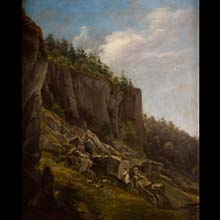
material: oil on paper mounted on canvas
dimensions: 67,5 x 54 cm
description: Besides works devoted to the Tatra mountains, Głowacki also painted landscapes showing the surroundings of Krakow. These works, executed with a view to recording the local colour of the Polish lands, are marked by the combination of the realistic rendering of details with the Romantic, lyrical atmosphere. Rendered in the style of Viennese Biedermeier and painted based on plein-air sketches, View of the Ojców Valley shows one of the picturesque spots of the Prądnik Valley. The motif of a slope with jagged, weird forms of limestone rocks, showed fragmentarily and in a considerable close-up, conveys the unique beauty of the place. The genre staffage adds to the romantic mood of landscape. A lady dressed as a shepherdess – according to tradition, Princess Izabela Sanguszkowa – inscribes a memento of the trip on the rock. Her gesture symbolizes a sentimental desire to leave in nature a mark of human presence. Rendered in subdued colours, the work is painted smoothly, with attention to detail. Views of the country – as landscapes were referred to in the time of Głowacki – were believed to convey patriotic ideas. The motifs employed in such works consolidated the knowledge of the native country, thus contributing to the cultivation of the national tradition and culture. Aleksandra Krypczyk
exposition: The Gallery of 19th Century Polish Art in Sukiennice,
The Cloth Hall, 1, Main Market Square
key: Romanticism. Towards national art >>>
dimensions: 67,5 x 54 cm
description: Besides works devoted to the Tatra mountains, Głowacki also painted landscapes showing the surroundings of Krakow. These works, executed with a view to recording the local colour of the Polish lands, are marked by the combination of the realistic rendering of details with the Romantic, lyrical atmosphere. Rendered in the style of Viennese Biedermeier and painted based on plein-air sketches, View of the Ojców Valley shows one of the picturesque spots of the Prądnik Valley. The motif of a slope with jagged, weird forms of limestone rocks, showed fragmentarily and in a considerable close-up, conveys the unique beauty of the place. The genre staffage adds to the romantic mood of landscape. A lady dressed as a shepherdess – according to tradition, Princess Izabela Sanguszkowa – inscribes a memento of the trip on the rock. Her gesture symbolizes a sentimental desire to leave in nature a mark of human presence. Rendered in subdued colours, the work is painted smoothly, with attention to detail. Views of the country – as landscapes were referred to in the time of Głowacki – were believed to convey patriotic ideas. The motifs employed in such works consolidated the knowledge of the native country, thus contributing to the cultivation of the national tradition and culture. Aleksandra Krypczyk
exposition: The Gallery of 19th Century Polish Art in Sukiennice,
The Cloth Hall, 1, Main Market Square
key: Romanticism. Towards national art >>>












